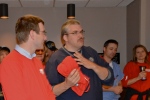In The American Nurse, photographer and award-winning filmmaker Carolyn Jones, through quiet photographs and deeply moving text, tells the personal stories of 75 nurses from across the U.S.–and in doing so gives voice to millions of women and men playing an important role every day in America’s healthcare system. One of the lucky winners of our recent photo contest will be receiving a copy of this book. The American Nurse Project was made possible with the support of Frenenius Kabi and includes… Continue reading
Continue reading
Save Hospital Services at Baystate Franklin Medical Center-Attend a Community Rally—Keep Care in Franklin County!
When: Thursday, July 25 at 5:30 p.m.
Where: High Street in front of Franklin Medical Ctr.
Following the rally, join us at Beacon Field for a community ice cre…
HMOs’ piggy banks get bigger
Minnesota’s HMOs continue to bank huge surpluses. According to health care analyst Allan Baumgarten’s report, which was cited here by the Twin Cities Business Journal, health plans in the state collectively socked away $241 million in 2012. That’s up from 2011 profits of $230 million.
HMOs will disagree with the word profits, as they’re non-profits, but their revenues combined mean they’re now sitting on $1.9 billion in savings. State law require them to save money to remain solvent, but the latest figures show the state’s health plans are now banking $1.3 billion more than regulations require.
HealthPartners alone generated nearly $128 million in operating income over the past two years, which earns it the title of most profitable HMO in the state. That means employers and their employees are grossly overpaying HMOs for medical coverage. A bill, however, that would require HMOs to only maintain a net worth limited to just 25 percent of their expenses never saw the light of day in the legislature last year.
The TCBiz Journal reports the HMOs have also applied to sell coverage on the MNSure Exchange next fall, and Baumgarten expects these insurers will be offering limited range of provider coverage on the network to keep costs down and profits up.
Nurses not the only ones paying attention to staffing problems
When the Robert Wood Johnson Foundation and the National Institute on Nursing Research released a study on the effects of nurse staffing in NICUs, it was a unique look into how nurse workloads affect non-adult patient outcomes. The study was conducted by researchers from the University of Pennsylvania, University of Medicine and Dentistry of New Jersey, Ohio State University, Dartmouth College, and the University of Vermont. Data was collected at 67 Vermont-Oxford Network hospitals on very-low-birthweight (VLBW) babies hospitalized between 2008 and 2009. Surveys on nurse staffing levels and patient acuity levels were tracked daily.
The result was not surprising. The researchers say that staffing below national guidelines by just .1 nurse-per-infant led to a shocking 40% increased risk of infection. Just one-tenth less. What’s more is the hospitals studies were considered to have excellent nursing care and staffing levels, but even these hospitals were found to be understaffing below national standards by 47 percent in 2008 and 31 percent in 2009. The sickest babies were understaffed the most. On a scale of 1 to 5, the sickest category 4 and 5 babies were found to be understaffed 80 percent of the time in 2008 and 68 percent in 2009. The full study was published in the Journal of Pediatric Medicine and here at MedScape News (sign-up required).
The Illinois Medical Malpractice website picked up on the study too. What’s interesting is malpractice attorneys cite staffing as not a one-time error, but a “symptomatic” error that’s caused directly by administrator decisions to keep costs down. That’s a conscious decision that has a direct effect of increasing the chance of infection and possibly long-term care for a patient. The attorneys write that, “it is absolutely incumbent up all facilities not to prioritize profits over patients in this way.” link here
What if the threat of malpractice forced hospital administrators to take a closer look at the staffing decisions they make every day?
ANA Leadership Institute: Call for Faculty
ANA System Upgrade
ANA will be upgrading its Personify Association Member Management system this weekend. This upgrade is part of ANA’s continuing journey to the Cloud and improvement of its IT infrastructure. The upgrade will take place from 5:00 PM Friday, July 12 thru Sunday, July 14. ANA’s Software vendor and ANA IT staff will be working together to load the new Cloud based systems with all of the most up to date member data over the weekend and testing to ensure all is well before Monday morning.
Over the weekend, members/customers will NOT be able to do the following:
- Join online
- Update member/customer information.
- Pay dues or renew their membership online.
- Make donations of any type on the nursingworld.org site.
- Purchase books or complete any financial or ecommerce transactions.
Over the weekend members/customers will be able to:
- Log into the website and access their “My ANA” pages.
ALERT NOTICE!! ANA Will be Performing System Maintenance This Weekend
Plastic Surgery Nurses Help Give Patients a Fresh Start
This Week In America: A Nation of Part Time Work
The American jobs disaster is finally getting some media attention, finally, after the White House, Congress and Wall Street have combined to cast a dire crisis in employment as a moderate condition contributing to a well-anchored recovery. The Washington Post reminded that the latest jobs report included 322,000 new part-time jobs- “a number that comprises only part-timers who want full-time work but can’t find it.” Prominent among these very substantial numbers are Americans age 25 and under, forced to cobble together something of a living with part-time stints. Small wonder poverty and near-poverty continue a steady, ominous rise in the U.S.
Of the 195,000 jobs created in June, fully 75,000 came in “Leisure and Hospitality,” the Post explained, “Labor Department-speak for hotels, restaurants, fast-food joints and bars. Workers in this sector averaged just 26.1 hours a week.” Six thousand manufacturing jobs were eliminated in June.
“Worse yet,” chimed the Post, “the jobs being created paid a lot less than the jobs that were lost. While the average hourly wage of non-supervisory employees in manufacturing was $19.26 in June, it was $13.96 for retail employees and $11.75 for hotel and restaurant workers” According to the National Employment Law Project, the median hourly wages of all American workers declined 2.8 percent from 2009 to 2012.
Employers regularly use workers from temp agencies—10,000 were employed in this fashion in June, it was reported. “The advantages are clear: Employers are under no pressure to provide raises or benefits to temporary workers, nor are they legally liable if the workers turn out to be undocumented or are hurt on the job.”
Michael Grabell in ProPublica and reprinted on Alternet profiled the temp sector: “In cities all across the country, workers stand on street corners, line up in alleys or wait in a neon-lit beauty salon for rickety vans to whisk them off to warehouses miles away. Some vans are so packed that to get to work, people must squat on milk crates, sit on the laps of passengers they do not know or sometimes lie on the floor, the other workers’ feet on top of them….
“The people here are not day laborers looking for an odd job from a passing contractor. They are regular employees of temp agencies working in the supply chain of many of America’s largest companies – Walmart, Macy’s, Nike, Frito-Lay. They make our frozen pizzas, sort the recycling from our trash, cut our vegetables and clean our imported fish. They unload clothing and toys made overseas and pack them to fill our store shelves. They are as important to the global economy as shipping containers and Asian garment workers.”
“In June,” summed up ProPublica, “the nation had more temp workers than ever before. Overall, almost one-fifth of the total job growth since the recession ended in mid-2009 has been in the temp sector, federal data shows.
Low U.S. Wages Spell Demise. This same June data from the Labor Department showed that 3.6 million workers earned the minimum wage by 2012, a surge since 2007, when that number totaled 1.7 million, according to the New York Times.
When it comes to comparative median wealth among industrial countries, the U.S. has fallen to 27th—an indication of the gross inequality that’s come to define this nation. The Huffington Post reports that while “the U.S. is the richest country on Earth” – with “hedge fund managers who make in one hour as much as the average family in 21 years!” – “there are 26 other countries with a median wealth higher than ours….” Just ahead of us: Kuwait and Cyprus.
Not Much Equality in New Mexico. Writing in CounterPunch, Carol Miller outlines child poverty in that state, where the overall poverty rate hovers at 20 percent. “Since 2000 the number of poor children in the U.S. has increased by more than 5 million, wrote Miller. “Nearly half of these children live in extreme poverty, including two and a half million children under the age of five. In sparsely populated New Mexico, at least 150,000 children live in poverty and nearly 80,000 in extreme poverty.”
A mom and a child in New Mexico receive a maximum of $304 per month as cash assistance, Temporary Assistance for Needy Families (TANF). In New Mexico, Miller pointed out, a family needs to have five members to get over $500 per month.
“When adjusted for inflation, New Mexico ‘benefits’ have declined 31 percent in real dollars since President Clinton signed welfare reform in 1996,” she wrote.
“It is time to create jobs that pay a living wage and provide health care,” said Miller. “Jobs that build capacity and infrastructure throughout the state, like libraries, recycling centers, environmental clean-up, forest thinning and fuel use instead of controlled burns, sewer line construction and wastewater management, playgrounds – the list can go on and on.”
It is critical to note that nearly half of poor African-American children live in neighborhoods with concentrated poverty, defined as areas where 30 percent of the census tract population lives below the federal poverty threshold (on less than $18,000 for a family of three), according to The Nation.
A Very Soft Landing. For some, it is business as usual, as the plethora of low-wage and temp jobs translates to riches. “Golden Parachutes Are Still Very Much in Style,” headlined a recent New York Times article. “ Executives who choose to retire… often receive millions when they leave. And despite years of public outcry against such deals, multimillion-dollar severance packages are still common.” Take, for example, James J. Mulya, Conoco Phillips CEO, who exited with a packaged valued at $156 million– the market value of stock gains he received plus payouts from a cash severance, a bonus and additional retirement distributions.
“In some cases,” the Times reported, “retiring chief executives will continue to receive millions years after their retirement. Edward D. Breen of Tyco International received deferred shares worth more than $55 million, added to “$30 million more as a lump-sum pension payment in 2016 as part of his employment agreement.”
John R. Charman, the former chairman and chief executive of Axis Capital Holdings, an insurer and reinsurer based in Bermuda, was forced out his top job. Still, “he received more than $26.5 million to walk away from the company.”
For Vikram S. Pandit, the former chief of Citigroup, who had to forego his agreed-upon parachute amidst revelations of that mega-bank’s misdeeds surrounding the financial collapse of 2008, the parachute was less-than-gilded, by comparison. But Citigroup’s board awarded Pandit $6.7 million as a 2012 bonus. Still makes for a very soft landing.
“Pandit” rhymes with…?
Synthetic Drug Committee Meets Again

State Rep. Erik Simonson (right) at a recent rally for nurses in Duluth with fellow Rep. Jason Metsa (left).
Minnesota lawmakers met at the Capitol on Tuesday to discuss ways to combat the spread of synthetic drug abuse that his hit Duluth, Hibbing, and other places spread wide across the state. The newly-formed “Select Committee on Controlled Substances and Synthetic Drugs” created by House Speaker Paul Thissen and headed by Duluth State Representative Erik Simonson is charged with holding hearings across the state and reporting back to the legislature by February 25th with recommendations.
Unlike traditionally banned drugs, manufacturers of synthetic drugs, often referred to as “bath salts,” are continually creating different drug formulas in a response to the banning of chemicals used to make the synthetic substances, which effectively replaces banned chemicals with new ones. Manufacturers are staying one step ahead of law enforcement officers.
MNA nurses see the damage done by synthetic drugs firsthand, and they’ve been speaking up about the increase in this type of drug use,. They report patients admitted with physical symptoms such as vomiting, seizures and escalated blood pressure as well as psychiatric symptoms such as paranoia, hallucinations, and violent psychosis. The devastation to the health of the user and their families, as well as the violence and crime related to the drug usage continues to destroy the social structures in these hard hit communities. Additionally, the increase in violence coming from patients under the influence of synthetic drugs continues to endanger other patients and those who care for them. The Minnesota Nurses Association is very supportive of the charge of this committee and is committed to helping find a solution that will prevent further damage to these patients and communities.
In Hibbing, Fairview Range University Medical Center-Mesabi’s psychiatric unit has seen a dramatic increase in admissions related to synthetic drugs and related violence on the unit. Hospitals in Duluth, Winona and other cities have identified similar increases in patient numbers and the violent behavior associated with synthetic drugs.
Tuesday’s hearing focused primarily on testimony from experts on the subject of synthetic drugs including Cody Wiberg, Executive Director of the MN Board of Pharmacy, Violet Stephens, Foresnic Scientist with the BCA, and Brian Marquart, the Statewide Coordinator for the Law Enforcement Task Forces.
After hearing extensive testimony from the expert panel, the committee discussed options for moving forward including the idea of a “controlled substances omnibus bill” that would look at multiple approaches to fixing the problem. Possible solutions discussed were outlawing paraphernalia commonly used to take the synthetic substance, broadening the authority of the MN Board of Pharmacy to adopt an emergency rule declaring certain substances to be synthetic drugs, and heightening the ability of the Minnesota Attorney General deal with synthetic drugs on a broader scale.
The committee will continue to meet over the legislative break, with the next meeting convening in Brainerd at Central Lakes Community College on Thursday, August 22 starting at 5:30 PM. A September meeting of the taskforce is also being planned.
The committee is actively seeking input from the public on suggestions for related topics to discuss or focus on at the next meeting. If you have specific issues, information, or evidence related to synthetic drugs that you would like addressed, please contact committee chair, Representative Erik Simonson at rep.erik.simonson@house.mn.

